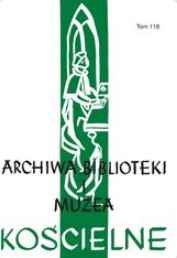Konserwatorska ocena stanu zachowania wybranych kazań kościelnych z lat 1541-1597 pochodzących z Biblioteki Fundacji Wiktora hr. Baworowskiego we Lwowie
ASSESSMENT OF THE STATE OF PRESERVATION OF SELECTED SERMONS FROM THE YEARS 1541–1597 FROM THE LIBRARY OF THE COUNT WIKTOR BAWOROWSKI FOUNDATION IN LVIV
Author(s): Agnieszka BangrowskaSubject(s): Museology & Heritage Studies, Library and Information Science, Theology and Religion, History of Religion
Published by: Katolicki Uniwersytet Lubelski Jana Pawła II - Wydział Teologii
Keywords: sermons; collection preservation assessment; Stanford method; pH
Summary/Abstract: The subject of the study was 16th-century biblical prints (15 selected sermons) from the collection of the Library of the Count Wiktor Baworowski Foundation in Lviv. Analysis of their preservation status was carried out using the Stanford method. It is a statistical method of assessing the state of preservation of book collections, used for this purpose in most studies of library collections (paper, book block, binding). The evaluation of the paper’s state of preservation takes into account its staining, discolouration, the degree of tearing and the number of double folds. When evaluating a book block, the degree of damage to the sewing or gluing ,which affects the strengthening of the pages in the block, is taken into account. The durability and the overall state of preservation of the surface are taken into account when evaluating the binding. The combined evaluation of these three criteria makes it possible to classify the examined item into one of three categories: prints in very good condition, prints in need of restoration work, and prints in very poor condition that should be taken out of use. An assessment of the state of preservation of the paper, block and binding of the biblical publications from the Lviv collection made it possible to classify the objects into the following categories: first – none; second – nine items, accounting for 60% of the total sample; third – six items, accounting for 40% of the total sample. The evaluation of each print was expanded to include ad-ditional paper strength tests and an assessment of the degree of acidity of the paper. The paper is in very good condition in terms of mechanical strength. Determination of the paper’s pH was performed by the contact method using an Elmetron CX-741 pH meter, with a composite EPX-3 electrode with an option to automatically determine the end of measurement. In each print, pH was tested at eight points. Five points were delineated on the title page, four of which were located in the corners of the title page and one in the centre. The three remaining measurements were taken on randomly selected pages in the book block, two on the unprinted area and one on the printed area. The measured pH value indicates low acidification rate. The average pH of the books studied is above pH 6, hence items with pH values above 6 do not require deacidification. On the basis of a visual analysis of the biological damage, it can be concluded that the book collection was not stored in optimal conditions in the past, as evidenced by the damage caused by insects, as well as fungi-based stains and streaks on paper.
Journal: Archiwa, Biblioteki i Muzea Kościelne
- Issue Year: 2022
- Issue No: 119
- Page Range: 5-27
- Page Count: 23
- Language: Polish

